Dell Inspiron B130 User Manual
Dell™ Inspiron™ 1300/B120/B130
Owner’s Manual
Model PP21L
w w w . d e l l . c o m | s u p p o r t . d e l l . c o m

Notes, Notices, and Cautions
NOTE: A NOTE indicates important information that helps you make better use of your computer.
NOTICE: A NOTICE indicates either potential damage to hardware or loss of data and tells you how to avoid the problem.
 CAUTION: A CAUTION indicates a potential for property damage, personal injury, or death.
CAUTION: A CAUTION indicates a potential for property damage, personal injury, or death.
Abbreviations and Acronyms
For a complete list of abbreviations and acronyms, see the Glossary.
If you purchased a Dell™ n Series computer, any references in this document to Microsoft® Windows® operating systems are not applicable.
Information in this document is subject to change without notice. © 2005 Dell Inc. All rights reserved.
Reproduction in any manner whatsoever without the written permission of Dell Inc. is strictly forbidden.
Trademarks used in this text: Dell, the DELL logo, Inspiron, Dell Precision, Dimension, DellNet, OptiPlex, Latitude, PowerEdge, PowerConnect,
PowerVault, PowerApp, and Dell OpenManage are trademarks of Dell Inc.; Intel, Celeron, and Pentium are registered trademarks of Intel Corporation; Microsoft, Outlook, and Windows are registered trademarks of Microsoft Corporation; EMC is a registered trademark of EMC Corporation.
Other trademarks and trade names may be used in this document to refer to either the entities claiming the marks and names or their products. Dell Inc. disclaims any proprietary interest in trademarks and trade names other than its own.
Model PP21L
September 2005 |
P/N WD660 |
Rev. A01 |

Contents
Finding Information . . . . . . . . . . . . . . . . . . . . . . . . . . . . . . . . 9
1 A Tour of Your Computer
Front View . . . . . . . . . . . . . . . . . . . . . . . . . . . . . . . . . . . . |
11 |
Left Side View . . . . . . . . . . . . . . . . . . . . . . . . . . . . . . . . . . |
14 |
Right Side View . . . . . . . . . . . . . . . . . . . . . . . . . . . . . . . . . |
16 |
Back View . . . . . . . . . . . . . . . . . . . . . . . . . . . . . . . . . . . . |
17 |
Bottom View . . . . . . . . . . . . . . . . . . . . . . . . . . . . . . . . . . . |
18 |
2 Setting Up Your Computer
Connecting to the Internet . . . . . . . . . . . . . . . . . . . . . . . . . . . . |
19 |
Setting Up Your Internet Connection . . . . . . . . . . . . . . . . . . . . |
19 |
Transferring Information to a New Computer . . . . . . . . . . . . . . . . . . |
20 |
Running the Files and Settings Transfer Wizard With the |
|
Operating System CD . . . . . . . . . . . . . . . . . . . . . . . . . . . . |
20 |
Running the Files and Settings Transfer Wizard Without the |
|
Operating System CD . . . . . . . . . . . . . . . . . . . . . . . . . . . . |
21 |
Setting Up a Printer . . . . . . . . . . . . . . . . . . . . . . . . . . . . . . . |
22 |
Printer Cable . . . . . . . . . . . . . . . . . . . . . . . . . . . . . . . . |
23 |
Connecting a USB Printer. . . . . . . . . . . . . . . . . . . . . . . . . . |
23 |
Power Protection Devices . . . . . . . . . . . . . . . . . . . . . . . . . . . . |
24 |
Surge Protectors . . . . . . . . . . . . . . . . . . . . . . . . . . . . . . |
24 |
Line Conditioners . . . . . . . . . . . . . . . . . . . . . . . . . . . . . . |
24 |
Uninterruptible Power Supplies . . . . . . . . . . . . . . . . . . . . . . |
24 |
Contents 3

3 |
Using the Display |
|
|
Adjusting Brightness. . . . . . . . . . . . . . . . . . . . . . . . . . . . . . . |
25 |
|
Switching the Video Image . . . . . . . . . . . . . . . . . . . . . . . . . . . |
25 |
|
Setting Display Resolution. . . . . . . . . . . . . . . . . . . . . . . . . . . . |
26 |
4 Using the Keyboard and Touch Pad |
|
|
|
Numeric Keypad . . . . . . . . . . . . . . . . . . . . . . . . . . . . . . . . . |
27 |
|
Key Combinations . . . . . . . . . . . . . . . . . . . . . . . . . . . . . . . . |
28 |
|
System Functions . . . . . . . . . . . . . . . . . . . . . . . . . . . . . . |
28 |
|
CD or DVD Tray . . . . . . . . . . . . . . . . . . . . . . . . . . . . . . . |
28 |
|
Display Functions . . . . . . . . . . . . . . . . . . . . . . . . . . . . . . |
28 |
|
Radios (Including Wireless Networking) . . . . . . . . . . . . . . . . . . |
28 |
|
Power Management . . . . . . . . . . . . . . . . . . . . . . . . . . . . |
28 |
|
Speaker Functions . . . . . . . . . . . . . . . . . . . . . . . . . . . . . |
29 |
|
Microsoft® Windows® Logo Key Functions . . . . . . . . . . . . . . . . |
29 |
|
Touch Pad . . . . . . . . . . . . . . . . . . . . . . . . . . . . . . . . . . . . |
30 |
|
Customizing the Touch Pad . . . . . . . . . . . . . . . . . . . . . . . . . |
30 |
5 |
Using a Battery |
|
|
Battery Performance . . . . . . . . . . . . . . . . . . . . . . . . . . . . . . . |
31 |
|
Checking the Battery Charge . . . . . . . . . . . . . . . . . . . . . . . . . . |
32 |
|
Dell™ QuickSet Battery Meter . . . . . . . . . . . . . . . . . . . . . . . |
32 |
|
Microsoft® Windows® Power Meter . . . . . . . . . . . . . . . . . . . |
32 |
|
Low-Battery Warning . . . . . . . . . . . . . . . . . . . . . . . . . . . . |
32 |
|
Conserving Battery Power . . . . . . . . . . . . . . . . . . . . . . . . . . . . |
32 |
|
Power Management Modes . . . . . . . . . . . . . . . . . . . . . . . . |
33 |
|
Configuring Power Management Settings . . . . . . . . . . . . . . . . . |
34 |
|
Charging the Battery . . . . . . . . . . . . . . . . . . . . . . . . . . . . . . . |
37 |
|
Replacing the Battery . . . . . . . . . . . . . . . . . . . . . . . . . . . . . . |
38 |
|
Storing a Battery . . . . . . . . . . . . . . . . . . . . . . . . . . . . . . . . . |
39 |
4 Contents

6 Using CDs, DVDs, and Other Multimedia
|
Playing a CD or DVD . . . . . . . . . . . . . . . . . . . . . . . . . . . . . . . |
41 |
|
Adjusting the Volume . . . . . . . . . . . . . . . . . . . . . . . . . . . . . . |
42 |
|
Adjusting the Picture . . . . . . . . . . . . . . . . . . . . . . . . . . . . . . |
43 |
|
Copying CDs and DVDs. . . . . . . . . . . . . . . . . . . . . . . . . . . . . . |
43 |
|
How to Copy a CD or DVD. . . . . . . . . . . . . . . . . . . . . . . . . . |
43 |
|
Using Blank CDs and DVDs . . . . . . . . . . . . . . . . . . . . . . . . . |
44 |
|
Helpful Tips . . . . . . . . . . . . . . . . . . . . . . . . . . . . . . . . . |
45 |
7 |
Using ExpressCards |
|
|
ExpressCard Types . . . . . . . . . . . . . . . . . . . . . . . . . . . . . . . . |
47 |
|
ExpressCard Blanks . . . . . . . . . . . . . . . . . . . . . . . . . . . . . . . |
47 |
|
Installing an ExpressCard . . . . . . . . . . . . . . . . . . . . . . . . . . . . |
47 |
|
Removing an ExpressCard or Blank . . . . . . . . . . . . . . . . . . . . . . . |
48 |
8 Setting Up a Home and Office Network |
|
|
|
Connecting to a Network Adapter . . . . . . . . . . . . . . . . . . . . . . . . |
49 |
|
Network Setup Wizard . . . . . . . . . . . . . . . . . . . . . . . . . . . |
49 |
|
Connecting to a Wireless Local Area Network . . . . . . . . . . . . . . . . . |
50 |
|
Determining Your Network Type . . . . . . . . . . . . . . . . . . . . . . |
50 |
|
Connecting to a Wireless Network in Microsoft® Windows® XP . . . . . |
50 |
9 |
Dell™ QuickSet Features |
|
|
Clicking the QuickSet Icon . . . . . . . . . . . . . . . . . . . . . . . . . . . |
53 |
|
Double-Clicking the QuickSet Icon . . . . . . . . . . . . . . . . . . . . . . . |
53 |
|
Right-Clicking the QuickSet Icon . . . . . . . . . . . . . . . . . . . . . . . . |
53 |
Contents 5

10 Solving Problems
Dell Diagnostics . . . . . . . . . . . . . . . . . . . . . . . . . . . . . . . . . |
55 |
Drive Problems . . . . . . . . . . . . . . . . . . . . . . . . . . . . . . . . . . |
58 |
CD and DVD drive problems . . . . . . . . . . . . . . . . . . . . . . . . |
58 |
Hard drive problems . . . . . . . . . . . . . . . . . . . . . . . . . . . . |
59 |
E-Mail, Modem, and Internet Problems . . . . . . . . . . . . . . . . . . . . . |
59 |
Error Messages . . . . . . . . . . . . . . . . . . . . . . . . . . . . . . . . . |
60 |
Keyboard Problems . . . . . . . . . . . . . . . . . . . . . . . . . . . . . . . |
64 |
External Keyboard problems . . . . . . . . . . . . . . . . . . . . . . . . |
64 |
Unexpected characters. . . . . . . . . . . . . . . . . . . . . . . . . . . |
64 |
Lockups and Software Problems . . . . . . . . . . . . . . . . . . . . . . . . |
65 |
The computer does not start up . . . . . . . . . . . . . . . . . . . . . . |
65 |
The computer stops responding . . . . . . . . . . . . . . . . . . . . . . |
65 |
A program stops responding or crashes repeatedly . . . . . . . . . . . . |
65 |
A program is designed for an earlier Microsoft® Windows® |
|
operating system . . . . . . . . . . . . . . . . . . . . . . . . . . . . . . |
65 |
A solid blue screen appears . . . . . . . . . . . . . . . . . . . . . . . . |
65 |
Other software problems . . . . . . . . . . . . . . . . . . . . . . . . . . |
66 |
Memory Problems . . . . . . . . . . . . . . . . . . . . . . . . . . . . . . . . |
66 |
Network Problems . . . . . . . . . . . . . . . . . . . . . . . . . . . . . . . . |
67 |
ExpressCard Problems . . . . . . . . . . . . . . . . . . . . . . . . . . . . . . |
67 |
Power Problems . . . . . . . . . . . . . . . . . . . . . . . . . . . . . . . . . |
67 |
Ensuring Sufficient Power for Your Computer . . . . . . . . . . . . . . . |
68 |
Printer Problems . . . . . . . . . . . . . . . . . . . . . . . . . . . . . . . . . |
68 |
Scanner Problems . . . . . . . . . . . . . . . . . . . . . . . . . . . . . . . . |
69 |
Sound and Speaker Problems . . . . . . . . . . . . . . . . . . . . . . . . . . |
69 |
No sound from integrated speakers . . . . . . . . . . . . . . . . . . . . |
69 |
No sound from external speakers . . . . . . . . . . . . . . . . . . . . . |
70 |
No sound from headphones . . . . . . . . . . . . . . . . . . . . . . . . |
70 |
Touch Pad or Mouse Problems . . . . . . . . . . . . . . . . . . . . . . . . . |
70 |
6 Contents

Video and Display Problems . . . . . . . . . . . . . . . . . . . . . . . . . . . |
71 |
If the display is blank . . . . . . . . . . . . . . . . . . . . . . . . . . . . |
71 |
If the display is difficult to read . . . . . . . . . . . . . . . . . . . . . . . |
71 |
If only part of the display is readable . . . . . . . . . . . . . . . . . . . . |
72 |
Drivers . . . . . . . . . . . . . . . . . . . . . . . . . . . . . . . . . . . . . . |
72 |
What Is a Driver? . . . . . . . . . . . . . . . . . . . . . . . . . . . . . . |
72 |
Identifying Drivers . . . . . . . . . . . . . . . . . . . . . . . . . . . . . |
72 |
Reinstalling Drivers and Utilities . . . . . . . . . . . . . . . . . . . . . . |
73 |
Resolving Software and Hardware Incompatibilities . . . . . . . . . . . . . |
75 |
Restoring Your Operating System . . . . . . . . . . . . . . . . . . . . . . . . |
75 |
Using Microsoft Windows XP System Restore . . . . . . . . . . . . . . . |
76 |
Using Dell PC Restore by Symantec . . . . . . . . . . . . . . . . . . . . |
77 |
Using the Operating System CD. . . . . . . . . . . . . . . . . . . . . . . |
79 |
11 Adding and Replacing Parts
Before You Begin. . . . . . . . . . . . . . . . . . . . . . . . . . . . . . . . . |
81 |
Recommended Tools . . . . . . . . . . . . . . . . . . . . . . . . . . . . |
81 |
Turning Off Your Computer . . . . . . . . . . . . . . . . . . . . . . . . . |
81 |
Before Working Inside Your Computer . . . . . . . . . . . . . . . . . . . |
81 |
Hard Drive . . . . . . . . . . . . . . . . . . . . . . . . . . . . . . . . . . . . |
83 |
Returning a Hard Drive to Dell . . . . . . . . . . . . . . . . . . . . . . . |
85 |
CD/DVD Drive. . . . . . . . . . . . . . . . . . . . . . . . . . . . . . . . . . . |
85 |
Memory. . . . . . . . . . . . . . . . . . . . . . . . . . . . . . . . . . . . . . |
86 |
Wireless Mini PCI Card . . . . . . . . . . . . . . . . . . . . . . . . . . . . . |
90 |
Hinge Cover . . . . . . . . . . . . . . . . . . . . . . . . . . . . . . . . . . . |
94 |
Keyboard . . . . . . . . . . . . . . . . . . . . . . . . . . . . . . . . . . . . . |
95 |
12 Appendix
Specifications . . . . . . . . . . . . . . . . . . . . . . . . . . . . . . . . . . |
97 |
Using the System Setup Program . . . . . . . . . . . . . . . . . . . . . . . |
103 |
Overview . . . . . . . . . . . . . . . . . . . . . . . . . . . . . . . . . |
103 |
Viewing the System Setup Screen . . . . . . . . . . . . . . . . . . . . |
103 |
Contents 7

System Setup Screen . . . . . . . . . . . . . . . . . . . . . . . . . . . |
103 |
Commonly Used Options . . . . . . . . . . . . . . . . . . . . . . . . . |
103 |
Travelling With Your Computer . . . . . . . . . . . . . . . . . . . . . . . . |
105 |
Identifying Your Computer . . . . . . . . . . . . . . . . . . . . . . . . |
105 |
Packing the Computer . . . . . . . . . . . . . . . . . . . . . . . . . . |
105 |
Travel Tips. . . . . . . . . . . . . . . . . . . . . . . . . . . . . . . . . |
105 |
Travelling by Air . . . . . . . . . . . . . . . . . . . . . . . . . . . . . . |
106 |
If Your Computer Is Lost or Stolen . . . . . . . . . . . . . . . . . . . . |
106 |
Cleaning Your Computer . . . . . . . . . . . . . . . . . . . . . . . . . . . . |
107 |
Computer, Keyboard, and Display . . . . . . . . . . . . . . . . . . . . |
107 |
Touch Pad . . . . . . . . . . . . . . . . . . . . . . . . . . . . . . . . . |
107 |
CDs and DVDs. . . . . . . . . . . . . . . . . . . . . . . . . . . . . . . |
107 |
FCC Notices (U.S. Only) . . . . . . . . . . . . . . . . . . . . . . . . . . . . |
108 |
FCC Class B . . . . . . . . . . . . . . . . . . . . . . . . . . . . . . . . |
108 |
Macrovision Product Notice. . . . . . . . . . . . . . . . . . . . . . . . . . |
109 |
Dell Technical Support Policy (U.S. Only) . . . . . . . . . . . . . . . . . . . |
109 |
Definition of "Dell-Installed" Software and Peripherals . . . . . . . . . |
109 |
Definition of "Third-Party" Software and Peripherals. . . . . . . . . . . |
109 |
Contacting Dell. . . . . . . . . . . . . . . . . . . . . . . . . . . . . . . . . |
110 |
Glossary . . . . . . . . . . . . . . . . . . . . . . . . . . . . . . . . . . . . . |
127 |
Index . . . . . . . . . . . . . . . . . . . . . . . . . . . . . . . . . . . . . . . . |
137 |
8 Contents
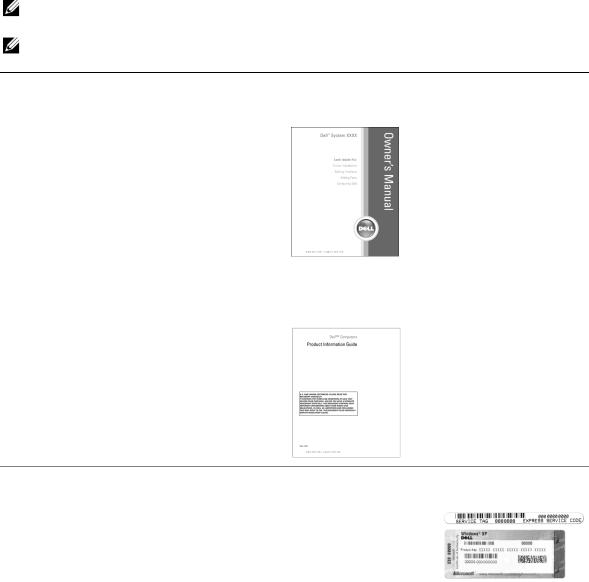
Finding Information
NOTE: Some features or media may be optional and may not ship with your computer. Some features or media may not be available in certain countries.
NOTE: Additional information may ship with your computer.
What Are You Looking For? |
Find It Here |
|
|
• How to set up my computer |
Owner’s Manual |
•Basic troubleshooting information
•How to run the Dell Diagnostics
•How to set up a printer
•Additional information about setting up my computer
•How to troubleshoot and solve problems
•How to remove and install parts
•Specifications
•How to contact Dell
|
NOTE: This document is available as a PDF at |
|
support.dell.com. |
|
|
• Warranty information |
Dell™ Product Information Guide |
•Terms and Conditions (U.S. only)
•Safety instructions
•Regulatory information
•Ergonomics information
•End User License Agreement
•Service Tag and Express Service Code
•Microsoft Windows License Label
Service Tag and Microsoft® Windows® License
These labels are located on the bottom of your computer.
• Use the Service Tag to identify your computer when you use support.dell.com or contact technical support.
•Enter the Express Service Code to direct your call when contacting technical support.
Finding Information |
9 |

What Are You Looking For? |
Find It Here |
|
|
• Solutions — Troubleshooting hints and tips, articles |
Dell Support Website — support.dell.com |
from technicians, and online courses, frequently asked |
NOTE: Select your region to view the appropriate support |
questions |
site. |
• Community — Online discussion with other Dell |
NOTE: Corporate, government, and education customers |
customers |
can also use the customized Dell Premier Support website at |
•Upgrades — Upgrade information for components, such premier.support.dell.com. as memory, the hard drive, and the operating system
•Customer Care — Contact information, service call and order status, warranty, and repair information
•Service and support — Service call status and support history, service contract, online discussions with technical support
•Reference — Computer documentation, details on my computer configuration, product specifications, and white papers
•Downloads — Certified drivers, patches, and software updates
• Notebook System Software (NSS)— If you reinstall the |
To download Notebook System Software: |
||
operating system for your computer, you should also |
1 |
Go to support.dell.com and click Downloads. |
|
reinstall the NSS utility. NSS provides critical updates |
2 |
Enter your Service Tag or product model. |
|
for your operating system and support for Dell™ |
|||
3 |
In the Download Category drop-down menu, click All. |
||
3.5-inch USB floppy drives, Intel® Pentium® M |
|||
processors, optical drives, and USB devices. NSS is |
4 |
Select the operating system and operating system |
|
|
language for your computer, and click Submit. |
||
necessary for correct operation of your Dell computer. |
|
||
|
|
||
The software automatically detects your computer and |
5 |
Under Select a Device, scroll to System and |
|
operating system and installs the updates appropriate |
|
Configuration Utilities, and click Dell Notebook System |
|
for your configuration. |
|
Software. |
|
|
|
||
• How to use Windows XP |
Windows Help and Support Center |
||
• How to work with programs and files |
1 |
Click the Start button and click Help and Support. |
|
• How to personalize my desktop |
2 |
Type a word or phrase that describes your problem and |
|
|
|
click the arrow icon. |
|
|
3 |
Click the topic that describes your problem. |
|
|
4 |
Follow the instructions on the screen. |
|
|
|
|
|
10 Finding Information
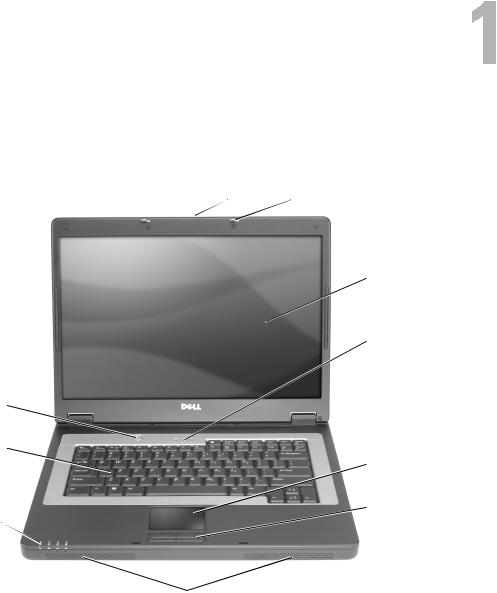
A Tour of Your Computer
Front View
1 |
2 |
|
3 |
|
4 |
10 |
|
9 |
|
|
5 |
|
6 |
|
8 |
|
|
|
|
|
|
|
7 |
|
|
1 |
display latch release |
5 |
touch pad |
9 |
keyboard |
2 |
display latches (2) |
6 |
touch pad buttons |
10 |
power button |
3 |
display |
7 |
speakers |
|
|
4 |
keyboard status lights |
8 |
device status lights |
|
|
A Tour of Your Computer |
11 |
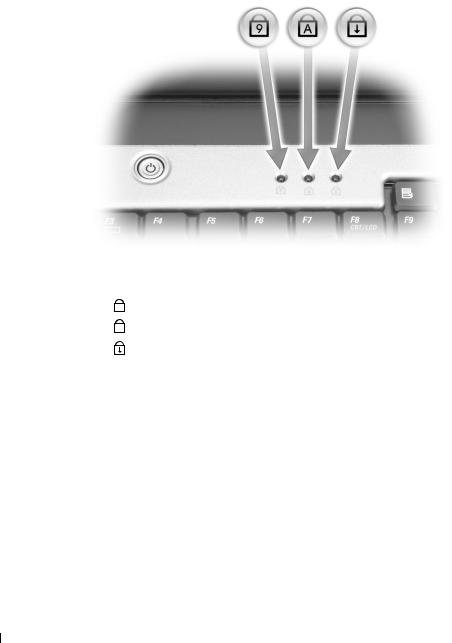
DISPLAY LATCH RELEASE — Slide to release the display latches and open the display.
DISPLAY LATCHES — Keeps the display closed.
DISPLAY — For more information about your display, see “Using the Display.”
KEYBOARD STATUS LIGHTS
The green lights located above the keyboard indicate the following:
9
A
Turns on when the numeric keypad is enabled.
Turns on when the uppercase letter function is enabled. Turns on when the scroll lock function is enabled.
TOUCH PAD/TOUCH PAD BUTTONS — Provides the functionality of a mouse.
SPEAKERS — To adjust the volume of the integrated speakers, press the speaker-volume keyboard shortcuts. For more information, see “Speaker Functions.”
12 A Tour of Your Computer

DEVICE STATUS LIGHTS
Turns on when you turn on the computer, and blinks when the computer is in a power management mode.
Turns on when the computer reads or writes data.
NOTICE: To avoid loss of data, never turn off the computer while the  light is flashing.
light is flashing.
Turns on steadily or blinks to indicate battery charge status.
Turns on when wireless networking is enabled. To enable or disable wireless networking, press <Fn><F2>.
NOTE: Wireless networking is optional and may not be available on your computer.
If the computer is connected to an electrical outlet, the  light operates as follows:
light operates as follows:
•Solid green: The battery is charging.
•Flashing green: The battery is almost fully charged.
If the computer is running on a battery, the  light operates as follows:
light operates as follows:
•Off: The battery is adequately charged (or the computer is turned off).
•Flashing orange: The battery charge is low.
•Solid orange: The battery charge is critically low.
KEYBOARD — The keyboard includes a numeric keypad as well as the Microsoft Windows logo key. For information on supported keyboard shortcuts, see “Key Combinations.”
POWER BUTTON — Press the power button to turn on the computer or to enter or exit a power management mode.
NOTICE: To avoid losing data when you turn off your computer, shut down your computer through the Start menu instead of pressing the power button.
A Tour of Your Computer |
13 |
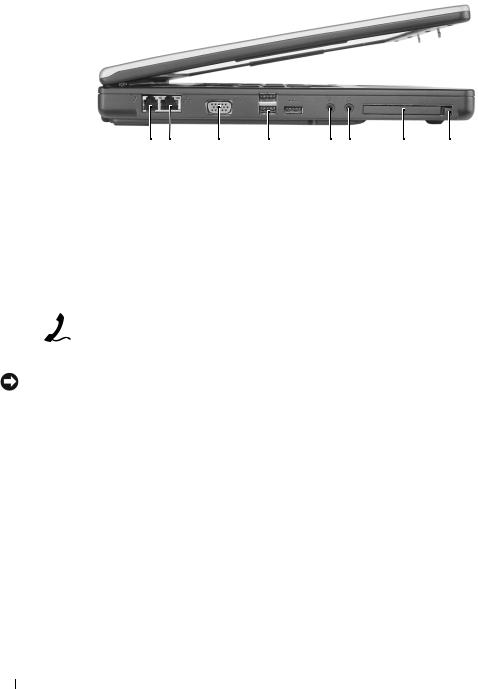
Left Side View
|
1 |
2 |
3 |
4 |
5 |
6 |
7 |
8 |
1 |
modem connector |
|
4 |
USB connectors (3) |
|
|
7 |
ExpressCard slot |
2 |
network connector |
|
5 |
microphone connector |
|
8 |
ExpressCard slot release |
|
|
|
|
|
|
|
|
|
button |
3 |
video connector |
|
6 |
headphone connector |
|
|
|
|
MODEM CONNECTOR (RJ-11)
To use the internal modem, connect the telephone line to the modem connector.
For additional information on using the modem, see the online modem documentation supplied with your computer.
NOTICE: The network connector is slightly larger than the modem connector. To avoid damaging the computer, do not plug a telephone line into the network connector.
14 A Tour of Your Computer

NETWORK CONNECTOR (RJ-45)
Connects the computer to a network. The green and yellow lights next to the connector indicate activity for wired network communications.
For information on using the network adapter, see the online network adapter documentation supplied with your computer.
VIDEO CONNECTOR
Connects an external VGA-compatible monitor.
USB CONNECTORS
Connect USB devices, such as a mouse, keyboard, or printer.
You can also connect the optional floppy drive directly to a
USB connector using the optional floppy-drive cable.
AUDIO CONNECTORS
Attach headphones or speakers to the  connector.
connector.
Attach a microphone to the |
connector. |
EXPRESS CARD SLOT — Supports one ExpressCard. The computer ships with a plastic blank installed in the slot. For more information, see “Using ExpressCards.”
A Tour of Your Computer |
15 |
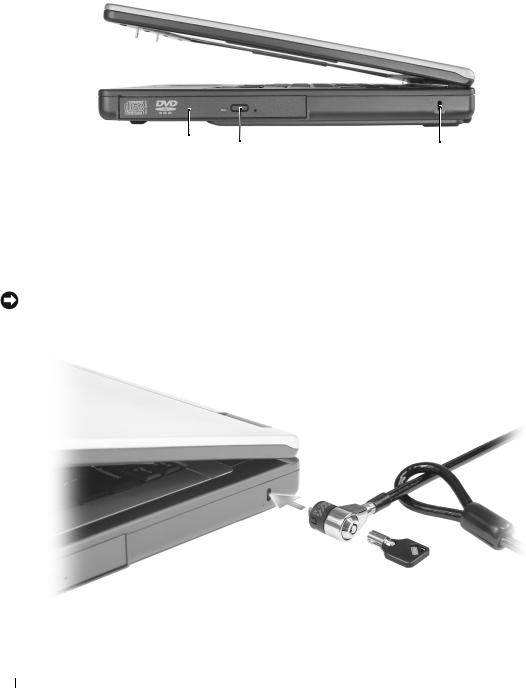
Right Side View
|
1 |
|
2 |
3 |
1 |
optical drive bay |
2 |
optical drive-tray eject button 3 |
security cable slot |
OPTICAL DRIVE — You can install devices such as a DVD drive or other optical drive in the optical drive bay. For more information, see “CD/DVD Drive.”
OPTICAL-DRIVE-TRAY EJECT BUTTON — Press this button to eject a CD or DVD from the optical drive.
SECURITY CABLE SLOT — Lets you attach a commercially available antitheft device to the computer. For more information, see the instructions included with the device.
NOTICE: Before you buy an antitheft device, ensure that it will work with the security cable slot.
16 A Tour of Your Computer
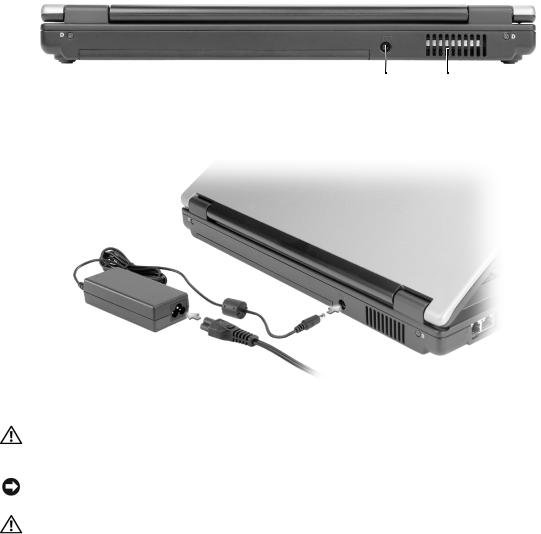
Back View
1 2
1 AC adapter connector 2 air vent
AC ADAPTER CONNECTOR — ATTACHES AN AC ADAPTER TO THE COMPUTER.
The AC adapter converts AC power to the DC power required by the computer. You can connect the AC adapter with your computer turned either on or off.
CAUTION: The AC adapter works with electrical outlets worldwide. However, power connectors and power strips vary among countries. Using an incompatible cable or improperly connecting the cable to the power strip or electrical outlet may cause fire or equipment damage.
NOTICE: When you disconnect the AC adapter cable from the computer, grasp the connector, not the cable itself, and pull firmly but gently to avoid damaging the cable.
CAUTION: Do not block or push objects into the air vents. Do not store your computer in a low-airflow environment, such as a closed briefcase, while it is running. Restricting the airflow can damage the computer or cause a fire.
AIR VENT — The computer uses fans to create airflow through the vents, which prevents the computer from overheating.
A Tour of Your Computer |
17 |
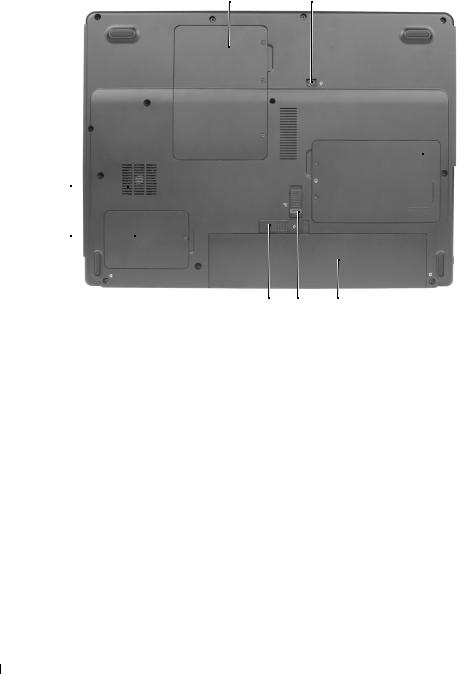
Bottom View
1 |
2 |
 3
3
8 
7 
|
|
|
6 |
5 |
4 |
|
1 |
memory module/Mini PCI |
4 |
battery |
|
7 |
thermal module cover |
|
cover |
|
|
|
|
|
2 |
optical drive locking screw |
5 |
battery-bay latch lock |
8 |
fan |
|
3 |
hard drive cover |
6 |
battery-bay latch release |
|
|
|
MEMORY MODULE/MINI PCI COVER — Covers the compartment that contains the memory module(s) and Mini PCI card. For more information on replacing memory, see “Memory.” For more information on replacing the Mini PCI card, see “Wireless Mini PCI Card.”
OPTICAL DRIVE LOCKING SCREW — Secures the optical drive in the optical drive bay. For more information, see “CD/DVD Drive.”
— Stores software and data. For more information, see “Hard Drive.”
BATTERY — When a battery is installed, you can use the computer without connecting the computer to an electrical outlet. For more information, see “Using a Battery.”
BATTERY-BAY LATCH LOCK — Unlocks the battery so that it can be released from the battery bay.
BATTERY-BAY LATCH RELEASE — Releases the battery from the battery bay. See “Replacing the Battery.”
PROCESSOR AND THERMAL MODULE COVER — Covers the processor and thermal module.
FAN — The computer uses fans to create airflow through the vents, which prevents the computer from overheating.
18 A Tour of Your Computer

Setting Up Your Computer
Connecting to the Internet
NOTE: ISPs and ISP offerings vary by country.
To connect to the Internet, you need a modem or network connection and an Internet service provider (ISP). Your ISP will offer one or more of the following Internet connection options:
•Dial-up connections that provide Internet access through a telephone line. Dial-up connections are considerably slower than DSL and cable modem connections.
•DSL connections that provide high-speed Internet access through your existing telephone line. With a DSL connection, you can access the Internet and use your telephone on the same line simultaneously.
•Cable modem connections that provide high-speed Internet access through your local cable TV line.
If you are using a dial-up connection, connect a telephone line to the modem connector on your computer and to the telephone wall jack before you set up your Internet connection. If you are using a DSL or cable modem connection, contact your ISP for setup instructions.
Setting Up Your Internet Connection
To set up an Internet connection with a provided ISP desktop shortcut:
1Save and close any open files, and exit any open programs.
2Double-click the ISP icon on the Microsoft® Windows® desktop.
3Follow the instructions on the screen to complete the setup.
If you do not have an ISP icon on your desktop or if you want to set up an Internet connection with a different ISP:
1Save and close any open files, and exit any open programs.
2Click the Start button and click Internet Explorer. The New Connection Wizard appears.
3Click Connect to the Internet.
4In the next window, click the appropriate option:
•If you do not have an ISP and want to select one, click Choose from a list of Internet service providers (ISPs).
Setting Up Your Computer |
19 |

•If you have already obtained setup information from your ISP but you did not receive a setup CD, click Set up my connection manually.
•If you have a CD, click Use the CD I got from an ISP.
5Click Next.
If you selected Set up my connection manually, continue to step 6. Otherwise, follow the instructions on the screen to complete the setup.
NOTE: If you do not know which type of connection to select, contact your ISP.
6Click the appropriate option under How do you want to connect to the Internet?, and then click Next.
7Use the setup information provided by your ISP to complete the setup.
If you are having problems connecting to the Internet, see "E-Mail, Modem, and Internet Problems." If you cannot connect to the Internet but have successfully connected in the past, the ISP might have a service outage. Contact your ISP to check the service status, or try connecting again later.
Transferring Information to a New Computer
The Microsoft® Windows® XP operating system provides a Files and Settings Transfer Wizard to move data from a source computer to a new computer. You can transfer data, such as:
•E-mail messages
•Toolbar settings
•Window sizes
•Internet bookmarks
You can transfer the data to the new computer over a network or USB connection, or you can store it on a removable medium, such as a writable CD or floppy, for transfer to the new computer.
NOTE: You can transfer information from the old computer to the new computer by directly connecting the two computers with a USB cable. To transfer data over a USB connection, you must access the Network Connections utility from the Control Panel and perform additional configuration steps, such as setting up an advanced connection and designating the host computer and the guest computer.
For instructions on setting up a direct cable connection between two computers, see Microsoft Knowledge Base Article #305621, titled How to Set Up a Direct Cable Connection Between Two Computers in Windows XP. This information may not be available in some countries.
For transferring information to a new computer, you must run the Files and Settings Transfer Wizard. You can use the optional Operating System CD for this process or you can create a wizard disk with the Files and Settings Transfer Wizard utility.
Running the Files and Settings Transfer Wizard With the Operating System CD
NOTE: This procedure requires the Operating System CD. This CD is optional and may not be included with all computers.
20 Setting Up Your Computer
To prepare the new computer for the file transfer:
1Start the Files and Settings Transfer Wizard.
2When the Files and Settings Transfer Wizard welcome screen appears, click Next.
3On the Which computer is this? screen, click New Computer and click Next.
4On the Do you have a Windows XP CD? screen, click I will use the wizard from the Windows XP CD and click Next.
5When the Now go to your old computer screen appears, go to your old or source computer. Do not click Next at this time.
To copy data from the old computer:
1On the old computer, insert the Windows XP Operating System CD.
2On the Welcome to Microsoft Windows XP screen, click Perform additional tasks.
3Under What do you want to do?, click Transfer files and settings.
4On the Files and Settings Transfer Wizard welcome screen, click Next.
5On the Which computer is this? screen, click Old Computer and click Next.
6On the Select a transfer method screen, click the transfer method you prefer.
7On the What do you want to transfer? screen, select the items you want to transfer and click Next. After the information has been copied, the Completing the Collection Phase screen appears.
8Click Finish.
To transfer data to the new computer:
1On the Now go to your old computer screen on the new computer, click Next.
2On the Where are the files and settings? screen, select the method you chose for transferring your settings and files and click Next.
The Files and Settings Transfer Wizard reads the collected files and settings and applies them to your new computer.
When all of the settings and files have been applied, the Finished screen appears.
3Click Finished and restart the new computer.
Running the Files and Settings Transfer Wizard Without the Operating System CD
To run the Files and Settings Transfer Wizard without the optional Operating System CD, you must create a wizard disk that will allow you to create a backup image file to removable media.
To create a wizard disk, use your new computer with Windows XP and perform the following steps:
1Click the Start button.
2Click Files and Settings Transfer Wizard.
3When the Files and Settings Transfer Wizard welcome screen appears, click Next.
Setting Up Your Computer |
21 |

4On the Which computer is this? screen, click New Computer and click Next.
5On the Do you have a Windows XP CD? screen, click I want to create a Wizard Disk in the following drive: and click Next.
6Insert the removable media, such as a floppy disk or CD, and click OK.
7When the disk creation completes and the Now go to your old computer message appears, do not click
Next.
8Go to the old computer.
To copy data from the old computer:
1On the old computer, insert the wizard disk.
2Click the Start button and click Run.
3In the Open field on the Run window, browse to the path for fastwiz (on the appropriate removable media) and click OK.
4On the Files and Settings Transfer Wizard welcome screen, click Next.
5On the Which computer is this? screen, click Old Computer and click Next.
6On the Select a transfer method screen, click the transfer method you prefer.
7On the What do you want to transfer? screen, select the items you want to transfer and click Next. After the information has been copied, the Completing the Collection Phase screen appears.
8Click Finish.
To transfer data to the new computer:
1On the Now go to your old computer screen on the new computer, click Next.
2On the Where are the files and settings? screen, select the method you chose for transferring your settings and files and click Next. Follow the instructions on the screen.
The wizard reads the collected files and settings and applies them to your new computer. When all of the settings and files have been applied, the Finished screen appears.
3Click Finished and restart the new computer.
NOTE: For more information about this procedure, search dell.support.com for document #PA1089586 (How Do I Transfer Files From My Old Computer to My New Dell™ Computer Using the Microsoft® Windows® XP Operating System?).
NOTE: Access to the Dell Knowledge Base document may not be available in some countries.
Setting Up a Printer
NOTICE: Complete the operating system setup before you connect a printer to the computer.
22 Setting Up Your Computer
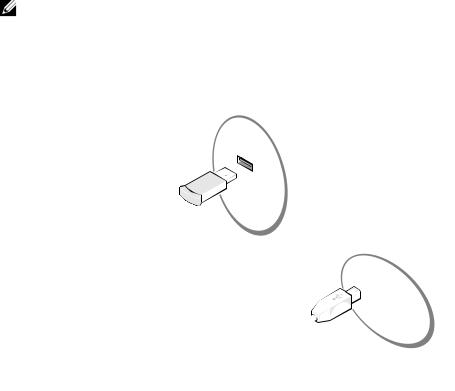
See the documentation that came with the printer for setup information, including how to:
•Obtain and install updated drivers.
•Connect the printer to the computer.
•Load paper and install the toner or ink cartridge.
For technical assistance, refer to the printer owner's manual or contact the printer manufacturer.
Printer Cable
Your printer connects to your computer with a USB cable. Your printer may not come with a printer cable, so if you purchase a cable separately, ensure that it is compatible with your printer and computer. If you purchased a printer cable at the same time you purchased your computer, the cable may arrive in the box in which your computer was shipped.
Connecting a USB Printer
NOTE: You can connect USB devices while the computer is turned on.
1Complete the operating system setup if you have not already done so.
2Attach the USB printer cable to the USB connectors on the computer and the printer. The USB connectors fit only one way.
 1
1
 3
3
 2
2
1 USB connector on computer 2 USB printer cable |
3 connector on printer |
Setting Up Your Computer |
23 |

3Turn on the printer and then turn on the computer. If the Add New Hardware Wizard window appears, click Cancel.
4Install the printer driver if necessary. See the documentation that came with your printer.
Power Protection Devices
Several devices are available to protect against power fluctuations and failures:
•Surge protectors
•Line conditioners
•Uninterruptible power supplies (UPS)
Surge Protectors
Surge protectors and power strips equipped with surge protection help prevent damage to your computer from voltage spikes that can occur during electrical storms or after power interruptions. Some surge protector manufacturers include warranty coverage for certain types of damage. Carefully read the device warranty when choosing a surge protector. A device with a higher joule rating offers more protection. Compare joule ratings to determine the relative effectiveness of different devices.
NOTICE: Most surge protectors do not protect against power fluctuations or power interruptions caused by nearby lightning strikes. When lightning occurs in your area, disconnect the telephone line from the telephone wall jack and disconnect your computer from the electrical outlet.
Many surge protectors have a telephone jack for modem protection. See the surge protector documentation for modem connection instructions.
NOTICE: Not all surge protectors offer network adapter protection. Disconnect the network cable from the network wall jack during electrical storms.
Line Conditioners
NOTICE: Line conditioners do not protect against power interruptions.
Line conditioners are designed to maintain AC voltage at a fairly constant level.
Uninterruptible Power Supplies
NOTICE: Loss of power while data is being saved to the hard drive may result in data loss or file damage.
NOTE: To ensure maximum battery operating time, connect only your computer to a UPS. Connect other devices, such as a printer, to a separate power strip that provides surge protection.
A UPS protects against power fluctuations and interruptions. UPS devices contain a battery that provides temporary power to connected devices when AC power is interrupted. The battery charges while AC power is available. See the UPS manufacturer documentation for information on battery operating time and to ensure that the device is approved by Underwriters Laboratories (UL).
24 Setting Up Your Computer

Using the Display
Adjusting Brightness
When a Dell™ computer is running on battery power, you can conserve power by setting the brightness to the lowest comfortable setting by pressing <Fn> and the upor down-arrow key on the keyboard.
The Dell QuickSet Brightness Meter shows the current brightness setting for the display. Right-click the  icon in the taskbar to enable or disable the Brightness Meter on the screen.
icon in the taskbar to enable or disable the Brightness Meter on the screen.
NOTE: By default, the Brightness Meter appears in the lower-right corner of the display. You can click and drag the meter to a preferred location.
NOTE: Brightness key combinations only affect the display on your portable computer, not monitors that you attach to your portable
computer or docking device. If your computer is connected to an external monitor and you try to change the brightness level, the Brightness Meter appears, but the brightness level on the monitor does not change.
You can enable or disable the Brightness Meter from the QuickSet taskbar menu. When the meter is enabled, press the following keys to adjust brightness:
•Press <Fn> and the up-arrow key to increase brightness on the integrated display only (not on an external monitor).
•Press <Fn> and the down-arrow key to decrease brightness on the integrated display only (not on an external monitor).
For more information on using QuickSet, right-click the  icon in the taskbar and click Help.
icon in the taskbar and click Help.
Switching the Video Image
When you start the computer with an external device (such as an external monitor or projector) attached and turned on, the image may appear on either the computer display or the external device.
Press <Fn><F8> to switch the video image between the display only, the external device only, or the display and the external device simultaneously.
Using the Display |
25 |

Setting Display Resolution
To display a program at a specific resolution, both the graphics card and the display must support the program, and the necessary video drivers must be installed.
Before you change any of the default display settings, make a note of the default settings for future reference.
If you choose a resolution or color palette that is higher than the display supports, the settings adjust automatically to the closest supported values.
1Click the Start button and click Control Panel.
2Under Pick a category, click Appearance and Themes.
3Under Pick a task..., click the area you want to change, or under or pick a Control Panel icon, click
Display.
4Try different settings for Color quality and Screen resolution.
NOTE: As the resolution increases, icons and text appear smaller on the screen.
26 Using the Display

Using the Keyboard and Touch Pad
Numeric Keypad
1
1 numeric keypad
The numeric keypad functions like the numeric keypad on an external keyboard. Each key on the keypad has multiple functions. The keypad numbers and symbols are marked in blue on the right of the keypad keys. To type a number or symbol, press <Fn> and the desired key after enabling the keypad.
• To enable the keypad, press <Num Lk>. The 9 light indicates that the keypad is active.
•To disable the keypad, press <Num Lk> again.
Using the Keyboard and Touch Pad |
27 |

Key Combinations
System Functions
<Ctrl><Shift><Esc> Opens the Task Manager window.
CD or DVD Tray
<Fn><F10> |
Ejects the tray out of the drive (if Dell QuickSet is |
|
installed). For more information on QuickSet, see |
|
“Dell™ QuickSet Features.” |
|
|
Display Functions
<Fn><F8> |
Switches the video image to the next display option. The |
|
options include the integrated display, an external |
|
monitor, and both displays simultaneously. |
|
|
<Fn> and up-arrow key |
Increases brightness on the integrated display only (not |
|
on an external monitor). |
|
|
<Fn> and down-arrow |
Decreases brightness on the integrated display only (not |
key |
on an external monitor). |
|
|
Radios (Including Wireless Networking)
<Fn><F2> |
Enables and disables radios, including wireless |
|
networking. |
|
NOTE: Wireless networking is optional and may not be |
|
available on your computer. |
|
|
Power Management
<Fn><Esc> |
Activates a power management mode. You can |
|
reprogram this keyboard shortcut to activate a different |
|
power management mode using the Advanced tab in the |
|
Power Options Properties window. See “Power |
|
Management Modes.” |
|
|
28 Using the Keyboard and Touch Pad

Speaker Functions
<Fn><Page Up> |
Increases the volume of the integrated speakers and |
|
external speakers, if attached. |
|
|
<Fn><Page Dn> |
Decreases the volume of the integrated speakers and |
|
external speakers, if attached. |
|
|
<Fn><End> |
Enables and disables the integrated speakers and external |
|
speakers, if attached. |
|
|
Microsoft® Windows® Logo Key Functions
Windows logo key and |
Minimizes all open windows. |
<m> |
|
|
|
Windows logo key and |
Maximizes all windows. |
<Shift><m> |
|
|
|
Windows logo key and <e> |
Runs Windows Explorer. |
|
|
Windows logo key and <r> |
Opens the Run dialog box. |
|
|
Windows logo key and <f> |
Opens the Search Results dialog box. |
|
|
Windows logo key and |
Opens the Search Results-Computer dialog box |
<Ctrl><f> |
(if the computer is connected to a network). |
|
|
Windows logo key and |
Opens the System Properties dialog box. |
<Pause> |
|
|
|
To adjust keyboard operation, such as the character repeat rate, open the Control Panel, click Printers and Other Hardware, and click Keyboard. For information about the Control Panel, see “Windows Help and Support Center.”
Using the Keyboard and Touch Pad |
29 |
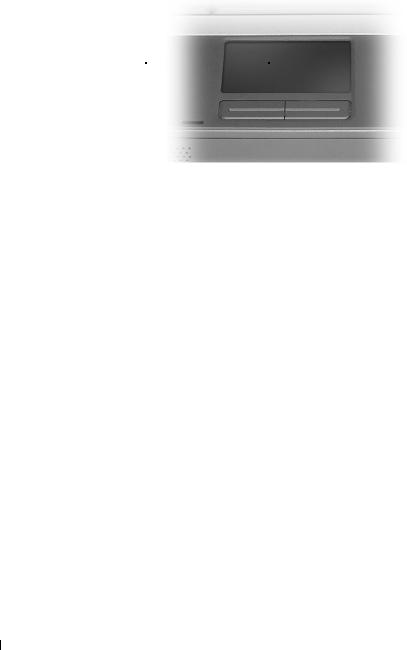
Touch Pad
The touch pad detects the pressure and movement of your finger to allow you to move the cursor on the display. Use the touch pad and touch pad buttons as you would use a mouse.
1
1touch pad
•To move the cursor, lightly slide your finger over the touch pad.
•To select an object, lightly tap once on the surface of the touch pad or use your thumb to press the left touch-pad button.
•To select and move (or drag) an object, position the cursor on the object and tap twice on the touch pad. On the second tap, leave your finger on the touch pad and move the selected object by sliding your finger over the surface.
•To double-click an object, position the cursor on the object and tap twice on the touch pad or use your thumb to press the left touch-pad button twice.
Customizing the Touch Pad
You can use the Mouse Properties window to disable the touch pad or adjust their settings.
1Open the Control Panel, click Printers and Other Hardware, and then click Mouse. For information about the Control Panel, see “Windows Help and Support Center.”
2In the Mouse Properties window, click the Touch Pad tab to adjust touch pad settings.
3Click OK to save the settings and close the window.
30 Using the Keyboard and Touch Pad
